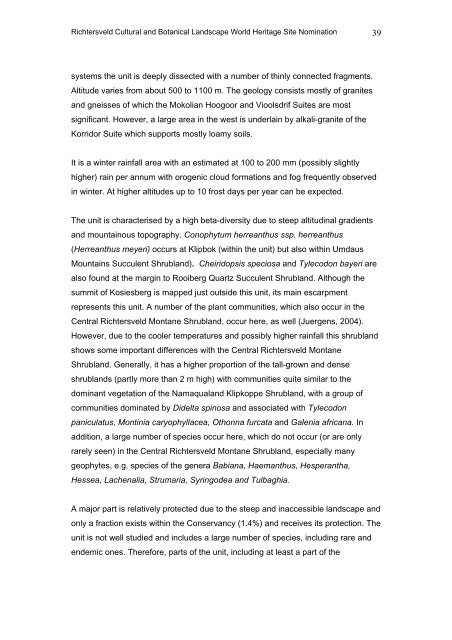the richtersveld cultural and botanical landscape - SAHRA
the richtersveld cultural and botanical landscape - SAHRA
the richtersveld cultural and botanical landscape - SAHRA
Create successful ePaper yourself
Turn your PDF publications into a flip-book with our unique Google optimized e-Paper software.
Richtersveld Cultural <strong>and</strong> Botanical L<strong>and</strong>scape World Heritage Site Nomination 39<br />
systems <strong>the</strong> unit is deeply dissected with a number of thinly connected fragments.<br />
Altitude varies from about 500 to 1100 m. The geology consists mostly of granites<br />
<strong>and</strong> gneisses of which <strong>the</strong> Mokolian Hoogoor <strong>and</strong> Vioolsdrif Suites are most<br />
significant. However, a large area in <strong>the</strong> west is underlain by alkali-granite of <strong>the</strong><br />
Korridor Suite which supports mostly loamy soils.<br />
It is a winter rainfall area with an estimated at 100 to 200 mm (possibly slightly<br />
higher) rain per annum with orogenic cloud formations <strong>and</strong> fog frequently observed<br />
in winter. At higher altitudes up to 10 frost days per year can be expected.<br />
The unit is characterised by a high beta-diversity due to steep altitudinal gradients<br />
<strong>and</strong> mountainous topography. Conophytum herreanthus ssp. herreanthus<br />
(Herreanthus meyeri) occurs at Klipbok (within <strong>the</strong> unit) but also within Umdaus<br />
Mountains Succulent Shrubl<strong>and</strong>). Cheiridopsis speciosa <strong>and</strong> Tylecodon bayeri are<br />
also found at <strong>the</strong> margin to Rooiberg Quartz Succulent Shrubl<strong>and</strong>. Although <strong>the</strong><br />
summit of Kosiesberg is mapped just outside this unit, its main escarpment<br />
represents this unit. A number of <strong>the</strong> plant communities, which also occur in <strong>the</strong><br />
Central Richtersveld Montane Shrubl<strong>and</strong>, occur here, as well (Juergens, 2004).<br />
However, due to <strong>the</strong> cooler temperatures <strong>and</strong> possibly higher rainfall this shrubl<strong>and</strong><br />
shows some important differences with <strong>the</strong> Central Richtersveld Montane<br />
Shrubl<strong>and</strong>. Generally, it has a higher proportion of <strong>the</strong> tall-grown <strong>and</strong> dense<br />
shrubl<strong>and</strong>s (partly more than 2 m high) with communities quite similar to <strong>the</strong><br />
dominant vegetation of <strong>the</strong> Namaqual<strong>and</strong> Klipkoppe Shrubl<strong>and</strong>, with a group of<br />
communities dominated by Didelta spinosa <strong>and</strong> associated with Tylecodon<br />
paniculatus, Montinia caryophyllacea, Othonna furcata <strong>and</strong> Galenia africana. In<br />
addition, a large number of species occur here, which do not occur (or are only<br />
rarely seen) in <strong>the</strong> Central Richtersveld Montane Shrubl<strong>and</strong>, especially many<br />
geophytes, e.g. species of <strong>the</strong> genera Babiana, Haemanthus, Hesperantha,<br />
Hessea, Lachenalia, Strumaria, Syringodea <strong>and</strong> Tulbaghia.<br />
A major part is relatively protected due to <strong>the</strong> steep <strong>and</strong> inaccessible l<strong>and</strong>scape <strong>and</strong><br />
only a fraction exists within <strong>the</strong> Conservancy (1.4%) <strong>and</strong> receives its protection. The<br />
unit is not well studied <strong>and</strong> includes a large number of species, including rare <strong>and</strong><br />
endemic ones. Therefore, parts of <strong>the</strong> unit, including at least a part of <strong>the</strong>

















